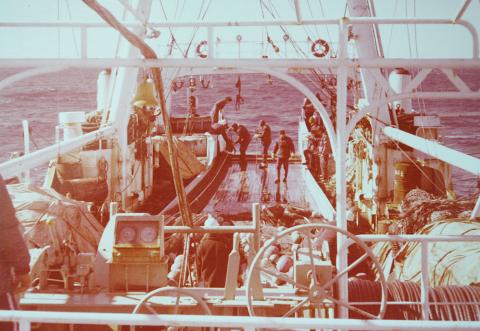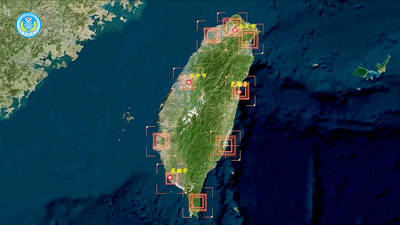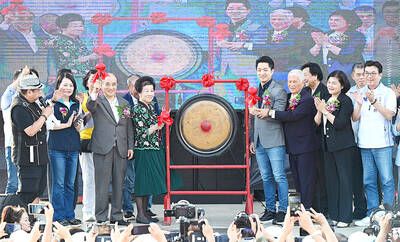Taiwan in Time: Dec. 21 to Dec. 27
After a 17,000km journey having survived devastatingly strong winds in regions dubbed the “roaring 40s, furious 50s and shrieking 60s” in reference to latitudes, the 711-ton Hai Kung (海功號) trawler ship drifted in the Antarctic waters in the middle of a snowstorm.
It was Jan. 23, 1977, World Freedom Day for Taiwan and South Korea. The crew of more than 30 researchers, sailors and journalists watched emotionally as the Taiwanese flag slowly rose in the frigid wind, its bright colors punctuating the gray skies.

Photo: Tang Sheng-yang, Taipei Times
It had been almost two months since they left Keelung in Taiwan’s first expedition ever to the bottom of the Earth. After making several rally cries, denouncing communism, slavery and fascism and calling for world peace, the crew produced a glass bottle containing a copy of Confucius’ Age of Great Harmony (禮運大同篇), hand-written by Teng Huo-tu (鄧火土), head of the Fisheries Research Institute, and dropped it into the ocean.
The bottle was meant to be buried in Antarctica’s ice sheet, and the flag planted on land, but the ship, lacking icebreakers and other equipment to properly navigate the perilous glaciers, could only sail near the continent while hauling in massive amounts of Antarctic krill. There were an estimated 40 to 60 billion tonnes of the shrimp-like crustaceans in the ocean, which were seen as a potential protein source for Taiwan’s increasing population amid unsure times as the country’s international standing continued to falter.
Two months later, the ship returned to Keelung with 140 tonnes of the catch to great fanfare. They were heroes.

Photo: Weng Yu-huang, Taipei Times
Taiwan’s development of its new fishing sources and methods became an urgent issue after the 1974 Third UN Conference on the Law of the Sea, where a proposal was made for a 200-nautical mile exclusive economic zone for coastal countries. Fishing experts were worried that it would greatly reduce the country’s traditional fishing grounds.
Members of the Joint Commission on Rural Reconstruction (today’s Council of Agriculture) decided to act preemptively by exploring possibilities in the Antarctic, where no Taiwanese ship had ever gone.
Hai Kung was built under Teng’s supervision for this purpose, completed in July 1975. Without icebreakers, it relied on sonar technology to avoid icebergs. It embarked on its maiden voyage on Dec. 24 that year, testing different equipment in the fishing grounds north of Taiwan in the East China Sea.
One year later, Hai Kung was deemed ready to make the big trip. It departed Keelung on Dec. 2, reaching Cape Town on Dec. 28, where it underwent more reinforcements and repairs before heading further south a week later.
Journalist Lu I-ming (呂一銘) recalls in his book about the journey passing through the various storm zones, where waves as high as mountains would hit the ship relentlessly, tilting it as much as 40 degrees. On Jan. 10, 1976, the crew shed tears of joy as they finally reached the Antarctic Ocean.
Lu writes that the ship almost got turned back at one point because of a telegram sent from Taiwan ordering the crew not to go further south than 50 degrees, which was revealed later to be a typo, as the officials actually meant 70 degrees.
The return journey was just as perilous, but the crew made it safely back to Cape Town on Feb. 17. Here, the ship reportedly received a mysterious crate from Taiwan’s ambassador to South Africa to bring back home with them. Several crew members later reported that they felt that the ship had a secret mission, especially when they were ordered to depart straight for Taiwan, without stops, before the sun even came up. Even the journalists, who had planned to visit England, were ordered to return home immediately.
A crew member said years later that the crate was delivered to the National Chung-Shan Institute of Technology and Science, prompting them to suspect that it was a missile. The book, Mission Antarctic (極地任務) published by the Taiwan Fisheries Economics Development Association and Chung Cheng Agriculture and Social Welfare Foundation states that indeed it was a military purchase, and suggests that it was a “type of radioactive heavy metal element,” prompting speculation that it was uranium.
There has been no definite conclusion yet.
Hai Kung would make several more expeditions to Antarctica before it was retired in 1993. Alas, the krill never became a food source reportedly because of its putrid smell and lack of meat, and is used today mostly as fishing bait. After its years of service and groundbreaking achievements, Hai Kung was moved ashore in 1998 at Keelung’s Bisha wharf (碧砂), where it sat mournfully, rusting and falling apart until it was recently restored.
Taiwan in Time, a column about Taiwan’s history that is published every Sunday, spotlights important or interesting events around the nation that have anniversaries this week.

The People’s Republic of China (PRC) last week offered us a glimpse of the violence it plans against Taiwan, with two days of blockade drills conducted around the nation and live-fire exercises not far away in the East China Sea. The PRC said it had practiced hitting “simulated targets of key ports and energy facilities.” Taiwan confirmed on Thursday that PRC Coast Guard ships were directed by the its Eastern Theater Command, meaning that they are assumed to be military assets in a confrontation. Because of this, the number of assets available to the PRC navy is far, far bigger

The 1990s were a turbulent time for the Chinese Nationalist Party’s (KMT) patronage factions. For a look at how they formed, check out the March 2 “Deep Dives.” In the boom years of the 1980s and 1990s the factions amassed fortunes from corruption, access to the levers of local government and prime access to property. They also moved into industries like construction and the gravel business, devastating river ecosystems while the governments they controlled looked the other way. By this period, the factions had largely carved out geographical feifdoms in the local jurisdictions the national KMT restrained them to. For example,

The remains of this Japanese-era trail designed to protect the camphor industry make for a scenic day-hike, a fascinating overnight hike or a challenging multi-day adventure Maolin District (茂林) in Kaohsiung is well known for beautiful roadside scenery, waterfalls, the annual butterfly migration and indigenous culture. A lesser known but worthwhile destination here lies along the very top of the valley: the Liugui Security Path (六龜警備道). This relic of the Japanese era once isolated the Maolin valley from the outside world but now serves to draw tourists in. The path originally ran for about 50km, but not all of this trail is still easily walkable. The nicest section for a simple day hike is the heavily trafficked southern section above Maolin and Wanshan (萬山) villages. Remains of

With over 100 works on display, this is Louise Bourgeois’ first solo show in Taiwan. Visitors are invited to traverse her world of love and hate, vengeance and acceptance, trauma and reconciliation. Dominating the entrance, the nine-foot-tall Crouching Spider (2003) greets visitors. The creature looms behind the glass facade, symbolic protector and gatekeeper to the intimate journey ahead. Bourgeois, best known for her giant spider sculptures, is one of the most influential artist of the twentieth century. Blending vulnerability and defiance through themes of sexuality, trauma and identity, her work reshaped the landscape of contemporary art with fearless honesty. “People are influenced by